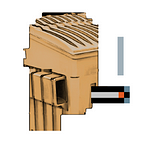Data as the new Oil: Sensors as the new Mines
This article presents the hypothesis that a properly set-up sensor can make profit. Citations are listed at the end.
Back in 2017 when I got into crypto, the way to make profit was to build a mine using GPUs. These rigs cost a few thousand dollars and could be run so that the cryptocurrency mined was more valuable than the electricity input; resulting in profit over time. While mining is still around, it is now dominated by ASIC specialty miners which have largely replaced GPUs. This article argues that buying and maintaining a sensor-system, or “oracle” may be the next profitable venture in crypto.
With Chainlink (LINK) up around 50% in the last week, the crypto community is a buzz with how the blockchain can interact with sensors, and the concept of “oracles.”
Chainlink is an “API bridging service” that seeks to unite the blockchain with oracles, which is another term for sensors that collect data in the real world. (1) For example, the RuuviTag product is a RFID sensor that detects temperature and humidity. In one novel usecase, a user has attached a RuuviTag to a turtle so that s/he can monitor the turtle’s environment in real time.
In this example the RuuviTag is the oracle, and Chainlink could be the API bridging service that would link the sensor to a blockchain, such as ethereum or iota. Once the sensor data is available on the blockchain, it can be monitized by anyone that wants to monitor the temperature and humidity around the turtle, with the sensor owner collecting revenue (hopefully, profit over time). This is the province of Streamr (DATA), Iota (IOTA), and other blockchain companies that seek to leverage the information collected by the sensors in data marketplaces.
Sensors will Have Reputations
Just like a seller on eBay, in the sensors will have reputations. Like on eBay, sensors with better reputations will stand to gain more profit than sensors with poor reputations. What is meant by the “reputation” of a sensor? To get a good reputation, a sensor will need to (A) consistently be online, and (B) provide high-quality data. The reputation of a sensor will be related to it’s profitability; the highest reputation sensors will tend to make the most profit (thus, profitability of a sensor may be an objective proxy for its reputation; the sensors that make the most profit will tend to have the highest quality data).
A Real World Example: Smart Parking
An example blockchain+sensor project in progress to be used for smart parking is called NetObjex. “IoT sensors installed in the parking area can fetch information such as time for which car remains parked and vehicle number to obtain the linked wallet address. The data gets stored in the blockchain and triggers smart contracts to automate payments.” (2)
For this project to work, it will rely on “oracles” or sensor that can detect if a particular parking spot is occupied. Lets compare two hypothetical oracles: Dan and Sue live in view of a particularly popular parking spot in a crowded city. Dan sets up a high-quality camera with a clear view of the parking space, streaming to a computer which is always online. Dan uses a “hot dog or not a hot dog” AI program to determine if the parking space is occupied by a car (as opposed to a pedestrian walking through it or a car driving by) and his computer feeds this information to either the ethereum, iota, or some other blockchain.
Dan also uses a backup power supply and a good internet service, so his parking space sensor provides quality data nearly 100% of the time. Sue, on the other hand, hooks up a low-quality camera which has only an obstructed view of the parking space. Sue does not rely on an AI to filter the video data, but rather uses a simple “street-color or not street-color” algorithm to determine if the parking space is occupied. She doesn’t use a backup power supply or a good internet service, so her sensor is only “up” about 75% of the time.
In this example, Dan’s oracle is expected to have a better reputation, and thus to be more profitable than Sue’s, since it would provide data that more accurately reflects the state of the real world than Sue’s. As a consquence, Dan would make more profit with his sensor than would Sue.
Part II
I will follow up this general line of thinking with future blockchain+sensors, blockchain+IoT, and blockchain+AI articles focusing on the role of the oracle/sensor as Chainlink and other blockchain companies envision it. My goal in writing these pieces is to encourage users to set up sensor/oracles and attempt to make profit with them, much like GPU mines in the old days.
